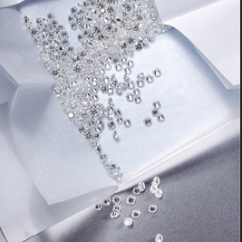Articles and News
SYNTHETIC DIAMONDS A CONCERN, BUT TREATED NATURAL STONES A BIGGER WORRY | February 13, 2013 (3 comments)

Scottsdale, AZ—Ever since IGI discovered more than 60% of the stones in a parcel of diamond melee were undisclosed synthetics, the industry has been on edge with worry that more unmarked, undisclosed synthetic diamonds will sneak into the marketplace posing as natural. Of particular concern to luxury jewelers is the fact that those stones were very high quality—the kind of melee they look for in merchandise.
Dealing With The New Hair-Raising Diamond & Gem Fakes Coming into Your Market, was the title of a panel discussion at the Centurion 2013 Show last week. Moderated by Terry Chandler of the Diamond Council of America, the panel included Alethea Inns of AGS Laboratories in Las Vegas, jeweler Jim Rosenheim of Tiny Jewel Box in Washington, DC, and Dr. James Shigley of Gemological Institute of America.
“What do you do to prevent synthetic stones from sneaking into the marketplace as naturals?” asked Chandler. The panelists acknowledged the tremendous problem of sorting synthetic stones form natural in a parcel of melee-sized stones. Treated color is easier to spot—a coating can be seen in a microscope, but colorless stones are much harder to spot.
“In a lab setting, it can be identified, but it’s not so easy out in the trade,” said Shigley. Over the past 25 years, GIA has done tremendous research about synthetic diamonds, but even so the lab still doesn’t see a huge amount of synthetics because most are small; i.e., stones less likely to be sent in for certificates.
“It’s easier to make a small synthetic than a large one,” he said, adding that’s why GIA recently instituted its Quality Assurance program to screen melee for synthetics. “Assume it’s in the marketplace,” said Rosenheim. He doesn’t worry about large stones since he won’t sell any without a certificate from either GIA or AGS, but he is working with Cecilia Gardner of the Jewelers’ Vigilance Committee to develop a warranty agreement for every vendor to sign.

Panelists Alethea Inns of AGS Labs, Jim Rosenheim of Tiny Jewel Box in Washington, DC, and Dr. James Shigley of GIA, The panel was moderated by Terry Chandler of Diamond Council of America (not pictured).
“You may want to suggest to your suppliers that they do the same with their loose suppliers,” he said. “It’s the best system till we can have a black box and test [for synthetics] ourselves.
“Tell your vendors, ‘We will do random testing,’ because all it takes is one problem, one customer years from now who gets an appraisal when there is a black box available, and it comes back ‘synthetic. It will be a mess for you. So if a vendor isn’t willing to provide a warranty, get a new vendor!” he emphasized.
“Test everything,” suggested Inns. “It’s very hard to keep up with the growers and treaters who are trying to deceive, but you have to be proactive.” She was quick to add that not all synthetic growers are deceptive—the ones in the United States have been very upfront about disclosure and in fact are quite proud of their products, she said, but overseas that hasn’t always been the case.
“Put yourself in the mind of the criminal,” said Chandler. When would be a good point to slip them into the supply? With so many over-the-counter sales today, that’s a perfect entry point, he suggested.
But for all the alarm, Shigley says synthetics still are a minuscule part of the market. A bigger, more immediate concern is the number of treated color diamonds slipping into the supply chain without disclosure. It’s not a new issue--irradiation has been going on since the 1950s, HPHT since the 1990s, and coating a stone has been happening since ancient times—but it’s a bear to identify because some treatments are designed specifically to hide previous treatments.
The panel summarized three action steps for retailers:
- Create an official policy on lab-grown stones, and have all your associates on board with it.
- Create an agreement with your vendors, in writing, that you will not accept undisclosed synthetic or treated stones. The warranty issue is the easiest step, reiterated Rosenheim. “You put the burden on manufacturers, your manufacturers put the burden on their stone suppliers, and so on up the marketplace.”
- Random test melee pieces such as wedding sets, semi-mounts, etc. Let vendors know you will be random testing products (and yes, it might mean destroying a few).
Finally, Chandler suggested retailers let their Millennial-age customers—their primary bridal target—know they’re protecting them from mistakenly buying synthetic stones.







